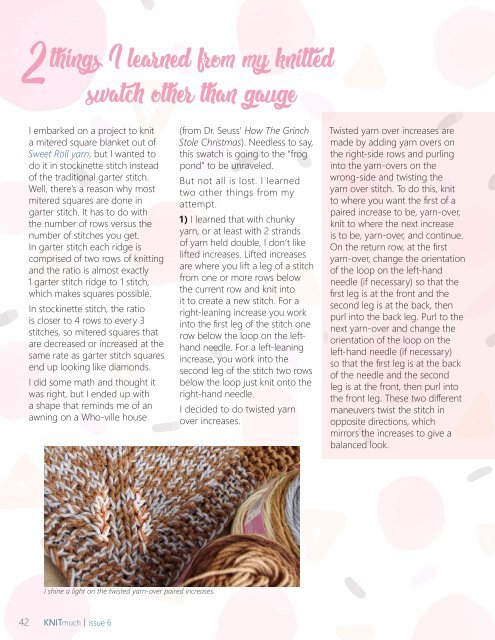KNITmuch | Issue 06
Here’s another issue you don’t want to miss! We’re talking about one of the more recent yarns Premier Toy Box, its characteristics, benefits and how perfect it is for knitting for children. We also look at non-allergenic sock yarns, and conversations about brioche knitting and knitting one stitch below using the luxurious Bella Cash. You’ll want to know about self striping yarns and examine what it’s like to knit with gradient striping yarn, Sweet Roll and Red Heart With Love Stripes and know the difference. Plenty of patterns to explore using Red Heart Soft and Evermore yarns.
Here’s another issue you don’t want to miss! We’re talking about one of the more recent yarns Premier Toy Box, its characteristics, benefits and how perfect it is for knitting for children. We also look at non-allergenic sock yarns, and conversations about brioche knitting and knitting one stitch below using the luxurious Bella Cash. You’ll want to know about self striping yarns and examine what it’s like to knit with gradient striping yarn, Sweet Roll and Red Heart With Love Stripes and know the difference. Plenty of patterns to explore using Red Heart Soft and Evermore yarns.
Create successful ePaper yourself
Turn your PDF publications into a flip-book with our unique Google optimized e-Paper software.
2<br />
things I learned from my knitted<br />
swatch other than gauge<br />
I embarked on a project to knit<br />
a mitered square blanket out of<br />
Sweet Roll yarn, but I wanted to<br />
do it in stockinette stitch instead<br />
of the traditional garter stitch.<br />
Well, there’s a reason why most<br />
mitered squares are done in<br />
garter stitch. It has to do with<br />
the number of rows versus the<br />
number of stitches you get.<br />
In garter stitch each ridge is<br />
comprised of two rows of knitting<br />
and the ratio is almost exactly<br />
1 garter stitch ridge to 1 stitch,<br />
which makes squares possible.<br />
In stockinette stitch, the ratio<br />
is closer to 4 rows to every 3<br />
stitches, so mitered squares that<br />
are decreased or increased at the<br />
same rate as garter stitch squares<br />
end up looking like diamonds.<br />
I did some math and thought it<br />
was right, but I ended up with<br />
a shape that reminds me of an<br />
awning on a Who-ville house<br />
(from Dr. Seuss’ How The Grinch<br />
Stole Christmas). Needless to say,<br />
this swatch is going to the “frog<br />
pond” to be unraveled.<br />
But not all is lost. I learned<br />
two other things from my<br />
attempt.<br />
1) I learned that with chunky<br />
yarn, or at least with 2 strands<br />
of yarn held double, I don’t like<br />
lifted increases. Lifted increases<br />
are where you lift a leg of a stitch<br />
from one or more rows below<br />
the current row and knit into<br />
it to create a new stitch. For a<br />
right-leaning increase you work<br />
into the first leg of the stitch one<br />
row below the loop on the lefthand<br />
needle. For a left-leaning<br />
increase, you work into the<br />
second leg of the stitch two rows<br />
below the loop just knit onto the<br />
right-hand needle.<br />
I decided to do twisted yarn<br />
over increases.<br />
Twisted yarn over increases are<br />
made by adding yarn overs on<br />
the right-side rows and purling<br />
into the yarn-overs on the<br />
wrong-side and twisting the<br />
yarn over stitch. To do this, knit<br />
to where you want the first of a<br />
paired increase to be, yarn-over,<br />
knit to where the next increase<br />
is to be, yarn-over, and continue.<br />
On the return row, at the first<br />
yarn-over, change the orientation<br />
of the loop on the left-hand<br />
needle (if necessary) so that the<br />
first leg is at the front and the<br />
second leg is at the back, then<br />
purl into the back leg. Purl to the<br />
next yarn-over and change the<br />
orientation of the loop on the<br />
left-hand needle (if necessary)<br />
so that the first leg is at the back<br />
of the needle and the second<br />
leg is at the front, then purl into<br />
the front leg. These two different<br />
maneuvers twist the stitch in<br />
opposite directions, which<br />
mirrors the increases to give a<br />
balanced look.<br />
I shine a light on the twisted yarn-over paired increases.<br />
42 <strong>KNITmuch</strong> | issue 6

















